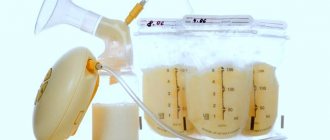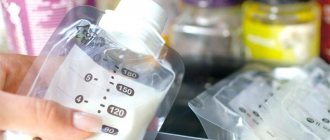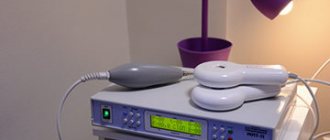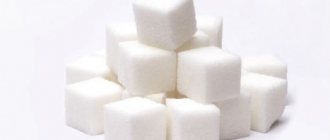Much has been said about the benefits of breast milk, but there are situations in which it is necessary to artificially terminate lactation. One of these reasons is the need to transfer the baby to general nutrition. Other reasons include certain diseases in a nursing woman and forced departure.
Forced interruption of lactation is a serious process that is recommended to be carried out under the strict supervision of a medical specialist.
Signs of readiness to stop breastfeeding
The body of a nursing mother ideally tells itself that breast milk ceases to be the main source of nutrition. You need to pay attention to some manifestations, which we will consider below.
During the day, the baby does not require mother's milk and is calm. If you do not apply to the breast for half a day, there is no feeling of fullness, painful aches, or desire to feed.
The child behaves as in infancy, constantly sucking at the breast . In turn, the nursing mother, instead of joy, experiences fatigue and a feeling of devastation.
This means that the needs of the son and daughter have increased, but the production of breast milk, on the contrary, is declining.
Medications
The advisability of using medications to stop lactation is determined individually, during a medical consultation. The action of such drugs is based on their influence on the brain and organs of the endocrine system. The effect of such drugs is unpredictable, so before prescribing them, the doctor must study the possible risks and consequences for the female body.
If the purpose of interrupting breastfeeding justifies the possible risks, then the specialist will select a specific drug and its dosage. Below we will present the most common means for medicinal completion of lactation.
- Bromocriptine
The action of this drug is based on inhibition of lactation function and normalization of the menstrual cycle. While taking this substance, it is necessary to constantly monitor blood pressure levels. Side effects include nausea, headache and dizziness. The necessary effect is achieved through long-term use of this drug.
- Bromcamphor
The active ingredient of the drug is bromine. The drug does not contain hormonal components. This remedy is characterized by a rapid effect on the body, and is recommended for use when it is necessary to immediately interrupt lactation. Bromcamphor not only inhibits the production of breast milk, but also has a sedative effect on the body.
Individual sensitivity to bromine components is identified as contraindications. Side effects from taking this substance are rare.
- Dostinex
The drug Dostinex is a potent centrally acting drug. The effect of the drug is due to its effect on the hypothalamus, which stimulates the production of substances that inhibit the synthesis of the hormone prolactin. After starting to take the substance, the production of breast milk immediately stops. The course of treatment is no more than 2 days.
Before using this substance, you should consult your doctor.
Ways to stop breastfeeding
The most important rule: do not retreat! Once the decision to transfer the baby “to the common table” has been made, there is no turning back.
Doubts and indecision will harm both: both mother and child, leading to physiological and psychological discomfort .
Act consistently, taking into account the necessary conditions that we will consider below .
To stop lactation, it is important to choose a cold season: autumn, winter or the first spring months. When the heat sets in , the risk of intestinal infections and various disorders increases.
The baby's health status should not be in doubt. If your beloved child is unwell or has been vaccinated , you should wait to stop breastfeeding.
All conditions are met, you are determined to switch to a new type of nutrition, then there are two ways to accomplish what you planned:
- abrupt interruption (“like a cut off”);
- gradual reduction in the number of feedings (it will take up to one and a half months).
breastfeeding is abruptly interrupted , plus one - short term, milk production will stop within a week.
But what will mother and child have to endure? Full breasts ache , which often leads to increased temperature, lactostasis, and mastitis. The baby becomes anxious and capricious.
It’s better to let changes into your life gradually. First, start reducing the number of feedings , eventually leaving only nighttime feedings. Teach your child to fall asleep without his mother; let his father or another family member put him to sleep temporarily. Instead of mother's milk, give him water to drink.
We read about the treatment of adenoids in children with folk remedies at home without surgery. We will read about the treatment of oral thrush in children in our new report. Opinion of experienced doctors.
And here we’ll look in detail at everything about Hirschsprung’s disease in children. Preventing illness.
What needs to be done to reduce lactation
Breast ligation to gradually reduce lactation
All processes in the human body are biologically determined, so lactation is a natural process that a child needs to maintain immunity and gradually adapt it to external conditions. The child grows up, but milk still enters the mammary glands? In this case, there are two solutions: you can go the natural route by bandaging your breasts and reducing the amount of liquid you drink per day, or you can use medications. How to make breast milk disappear quickly and painlessly?
Firstly, reduce feeding to a minimum, and secondly, accustom the child to a different type of food. This will take about a week, but it is the healthiest way to get rid of milk. If you immediately wean your baby during lactation, within a day the breasts will become hard, and mastitis awaits you. To interrupt lactation naturally and not harm yourself, consult a gynecologist or mammologist. Accompanying procedures may include tight wrapping for 2-3 hours a day, a course of hormonal medications to suppress milk production, and folk remedies against lactation.
Anti-lactation tablets
Medicines allow you to cope with the production of breast milk for an average of ten days.
They are mainly produced on the basis of hormones , so doctors are still arguing whether it is healthy to consume them.
In any case, advice from a gynecologist, taking into account the individual characteristics of a woman’s body, is mandatory. Be prepared for side effects .
Most often, doctors prescribe bromocamphor or dostinex (its analogue Alactin), bromocriptine, and less commonly parlodel, which causes nausea , a drop in blood pressure, vomiting, and dizziness.
Bromcamphor is a drug that is indicated to relieve anxiety; in the case of breastfeeding women, it inhibits the nervous system, regulating hormones, and does not act as quickly.
The approximate course of treatment is 10 days; patients often note a state of lethargy when taking it.
Pills for burning breast milk
All products to reduce lactation contain hormones. The doctor will prescribe therapy for you in accordance with your age and illnesses suffered during your life. Many drugs have serious contraindications; they should not be taken if you have kidney disease, diabetes, or joint and blood diseases. The most famous drugs are Dostinex and Bromocriptine. They affect prolactin and pituitary secretion effectively and quickly. The course of administration is from 10 to 15 days, half a tablet every 12 hours. During the first week, the dose can be increased from ¼ tablet to ½.
The medications have side effects such as dizziness, nausea, vomiting, surges in blood pressure, and even complete loss of consciousness. Interrupting lactation with medication is not recommended for women with heart pathologies and Parkinson's disease. Each tablet should be washed down with a glass of water, taken half an hour before meals.
It is important to remember that these medications are better tolerated if taken with food.
Among non-hormonal medications, Bromcamphor is a soothing drop that slows down the lactation process, gently minimizing it. But after you finish drinking them, the milk will begin to flow again, so this medicine is classified as one that is taken situationally.
Dr. Komarovsky about breastfeeding
Dostinex is a fast-acting hormonal drug, the effect is noticeable in a couple of days. It happens that after stopping the drug, lactation resumes.
Let's learn how to properly express breast milk by hand. Why is it recommended to do this? What do experts say on this issue? What are the side effects of DTP vaccination in children - https://mamavika.com/detsk-zdorov/uhod-za-malyishom/privivka-akds-pobochnyie-effektyi-u-detey.html. Is it worth getting this vaccination?
In addition to medications, there are more pleasant and painless ways to get rid of breast milk.
Natural cessation of breastfeeding
If you are not satisfied with the methods of traditional and folk medicine, you can choose the third method - the natural process of milk removal. Its essence lies in the abrupt weaning of the child from the breast (if this is necessary, of course) and periodic pumping. In this case, the mammary glands are emptied only until they soften, not completely.
As a result, the decrease in lactation will occur gradually, and after 7-10 days you will no longer need to pump. The main thing is to adhere to the following rules:
1) milk should be expressed when the breasts are as full as possible; 2) the bra for the period of cessation of lactation should be dense, providing support for the mammary glands without underwires; 3) drafts and contact of the chest with cold water should be avoided to avoid the development of mastitis; 4) it is better to express by hand; in extreme cases, you can use a breast pump; 5) it is necessary to minimize the amount of liquid consumed.
Note! Chest pain, increased body temperature, and the presence of lumps in the mammary glands are signs of the development of mastitis. If they are detected, you should immediately consult a doctor.
If you are forced to wean your baby against his wishes, this can be stressful for both the baby and the mother. However, stopping breastfeeding naturally is the safest method. If all the above rules are followed, milk burnout occurs without any complications.
Folk remedies to make breast milk disappear
Herbal infusions gradually “burn” mother’s milk, acting more carefully and harmoniously. The main “helper” for nursing mothers is the herb sage.
The decoction is prepared at the rate of a teaspoon per glass of water, leave for 15 minutes, drink several times a day in small sips. In 10-14 days, lactation “disappears.”
Herbs with a diuretic effect also help : lingonberry leaf, basil, parsley, removing excess fluid from the body and thereby strengthening the body’s immunity as a whole.
And remember: while a nursing woman needs to drink a lot of liquid, a mother who is stopping breastfeeding needs to drink little.
If your breasts become swollen , go straight to the doctor, don’t delay, a cabbage leaf will help from folk recipes: knead it a little, then apply a compress to the sore spot.
Many mothers, on an emotional level, painfully experience the refusal of breastfeeding, experiencing sadness and anxiety.
This is partly due to hormones. The hormonal levels stabilize, then the “sad” symptoms disappear.
And you can pick up your baby, rock him, stroke his head , while maintaining close contact with him, at any time, even after the breast milk has disappeared.
Means for stopping lactation
Our grandmothers and some mothers at one time stopped breastfeeding by tightly bandaging the breasts. But modern experts have long ago refuted the effectiveness of this method. In addition, putting pressure on the breasts can have negative consequences such as mastitis. Today there are 3 ways to stop lactation:
1) medicinal; 2) folk remedies; 3) natural cessation of breastfeeding (breastfeeding).
Note! Whatever method of stopping lactation you choose, you should periodically express your breasts to prevent milk stagnation.











